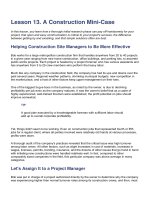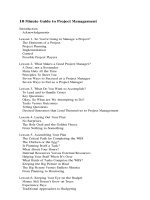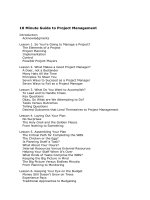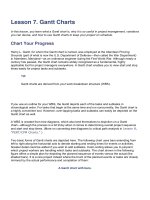10 Minute Guide to Investing in Stocks Chapter 4 pptx
Bạn đang xem bản rút gọn của tài liệu. Xem và tải ngay bản đầy đủ của tài liệu tại đây (350.32 KB, 9 trang )
I l@ve RuBoard
Lesson 4. What Is a Stock?
In this lesson you will learn what defines a stock, how stocks operate, and how to
differentiate among the various types of stock.
I l@ve RuBoard
I l@ve RuBoard
Stock Talk
A stock is a proportional ownership interest in a company. Or, in simplest terms, a stock is a
portion of the value of a company. When you buy stock in a company, you are actually
purchasing a piece of that company.
For example, let's say that we added up all of Widget Inc.'s assets, or the things that Widget
Inc. owns—computers, office buildings, etc.—and the value of everything came to $1,000.00.
Then let's say for argument's sake that Widget Inc. issues 1,000 shares of stock for people to
buy. If you buy one share of Widget Inc., you own 1/1,000 of everything that Widget Inc.
owns.
Plain English
A stock is a means by which the average person can purchase a company by
dividing its purchase price into shares small enough to be accessibly priced for
everyone.
You are actually an owner of the world-famous Widget Inc. company, and, as such, you get
all the rights and responsibilities that go along with being an owner. When the management
of Widget Inc. makes decisions regarding the company, like buying a new building, they need
to get your approval—yours and the other 999 people's, assuming each bought one share
like you. If you buy two shares you own twice as much of the company and have twice as
many votes in decisions on how it will be run. While the company's board of directors will
deal with most day-to-day issues, it is your vote which places them or removes them from the
board, thereby making you the ultimate authority. You can go to the company's annual
meeting and cast your vote, or you can vote by absentee ballot. The absentee ballot is called
a proxy; it is a legal form by which an investor votes in absentia, transferring his or her voting
authority to another party.
Plain English
A proxy is the ballot form that is sent to shareholders for their votes. Since few
people actually attend annual meetings, the word "proxy" has become synonymous
with the vote itself. Most people refer to "voting their proxy."
The rights and responsibilities of owning stock, as discussed earlier, both apply to a proxy in
that voting on how the company operates is a right reserved exclusively for stockholders. It is
also your responsibility, however, in that by not voting, you are leaving the management of
"your" company in the hands of others.
Dividends
When the company makes money, so do you—if you are a shareholder. The portion of a
corporation's after-tax earnings that is distributed to stockholders is called a dividend.
Companies can certainly lose money too, in which case there would be no dividends. You
would not, however, have to pay out any money, although the value of the stock would drop
as any company that is losing money is obviously less valuable.
TIP
When the company makes a profit, the whole profit, or some of it, is divided up
among everyone who has a share. These payments are called dividends (divide
up—dividends, get it?). Try to buy stock in a company that will continue to make a
profit.
Assets
Anything you own that's valuable is an asset.
I l@ve RuBoard
I l@ve RuBoard
What's a Company Worth?
Determining the value of a company is a little different from valuing tangible goods like cars
and houses. In both cases, you would list the real value of the components and the real value
of the liabilities, add the whole thing together, and the end sum would be the value of the
company.
For example, at Widget Inc. you could determine that the current stock of widgets is worth
$100, the office equipment and supplies are worth $100, and the building Widget Inc. owns is
worth $100. In addition, Widget Inc. owes its suppliers $50 and still has an outstanding
mortgage of $50, so you would subtract that $100 total and the end result of $200 would be
Widget Inc.'s value or net worth.
It gets a little more complicated than that, as the real value of a company is often in things
that are less tangible, name recognition, for example. Most people will buy Coca-Cola before
they buy generic soda, so there's actually value in owning the name Coca-Cola. The name
itself sells cans of soda. That's an edge that Coca-Cola has on the generic competition.
Unfortunately, that edge can't be documented on anything like a balance sheet. That edge is
one of Coca-Cola's assets, and it makes Coca-Cola a more valuable company.
Companies are often valued not at what they currently are, but at what they are capable of
becoming. This is called growth potential. For example, let's say yours is the only company in
America that makes Widgets from plastic; all the other companies make theirs from apples.
This year, there's a huge freeze and all the apple crops are lost. Since your little Widget
company is about to become the only company who can still produce Widgets, its value will
go through the roof even if at this moment you haven't actually changed a thing.
Plain English
An asset is an item on a balance sheet that shows the book value of something
owned. Anything you own that's valuable is an asset.
On the other side are those things that detract from a company's value, known as liabilities. A
liability can include anything such as outstanding debt, an inferior market share or position, or
a bad reputation. While a debt can certainly make its way onto the company's balance sheet,
again, the more intangible items such as a bad reputation or recent news events won't be
listed.
The biggest complication, however, is that you can't really put a price tag on these types of
things (what exactly is a good reputation worth? how much does a bad reputation hurt a
company's sales?), so stocks are actually worth only what people think they are worth. Or, in
other words, stocks are worth what people are willing to pay for them.
If you are willing to paint someone's house for $40, and someone is willing to pay you $40 to
do it, that's exactly what your service is worth. If you want $50 but can't find anyone to pay
that, then the service may not be worth $50. And the reverse is true too. If you agree to $40,
not knowing that someone would be willing to pay you $50, then the service is actually worth
$50 and you have just undersold yourself. In economic terms, this phenomenon is called
supply and demand. It's what drives the stock market and determines the prices of all stocks.
I l@ve RuBoard
I l@ve RuBoard
Kinds of Stock
The stocks themselves get a little more complicated than the paint job scenario just
mentioned. There are different kinds of stock, and they are differentiated by some very fine
print. While all stocks represent ownership of shares of a company, they aren't all alike. A
stock can be an actual document or a virtual notation on someone's computer. Here is a list
of stock categories:
Blue Chip Stock.
A share of one of the most established and financially secure companies in the country.
Secondary Stock.
A share of a company with substantial backing that is not quite considered blue chip.
Income Stock.
A stock that is usually characterized by its issuing company's focus on providing higher
dividends.
Growth Stock.
The stock of a company that is still small but is believed by its shareholders to have
great growth potential.
Penny Stock.
A highly speculative stock in a company with little or no real value other than its
uncertain growth potential.
I l@ve RuBoard
I l@ve RuBoard
The Two Main Issues of Stock
In addition to the unofficial kinds of stocks just discussed, the market has two issues of stock
to accommodate different types of investors: common stock and preferred stock. As a very
general rule, the benefits of common stock tend to be more geared for individual investors
while those of preferred stock tend to be more geared to the needs of institutional investors
such as pension funds, mutual funds, and banks.
Common Stock
Aptly named, common stock is the one most people think of when they hear the word stock.
It's also the kind of stock most widely bought and sold, or in investor lingo—traded. It
represents basic ownership of part of a company, as was described in the beginning of this
lesson. The owner of one share of common stock gets one vote, or one proxy, on company
matters. As stated earlier, two shares equals two votes and so on.
When the value of the company goes up as it did in the example of the apple crop freeze,
share owners make money because the value of the company has increased and
subsequently the stock has gone up also. This is called capital gain.
When discussing types of investments, you will often hear terms such as financial
"instruments" and "vehicles." These terms are not "financial terms" which imply anything
significant but simply words which are used interchangeably instead of less professional-
sounding terms such as "things" or "stuff."
Plain English
Capital is the original amount you invested in your financial instrument. A capital
gain is an appreciation of the value of the financial instrument, such as a stock, in
which the initial principal was invested. If your stock is worth more now than what
you paid for it, then you have realized a capital gain.
If you had bought stock in one of those companies that makes Widgets from apples, the
value of your company and subsequently its stock would have decreased because of the
deep freeze that destroyed the apple crop. You would have suffered what's called a capital
loss.
Capital gains and losses are one of the two ways stock make and lose money (the other
being dividends). In addition, however, other factors such as the taxes on capital gains
should always be taken into consideration. Current capital gains taxes are so high as to often
negate much of a stock's potential earnings and make many stocks unattractive to investors
for that reason. As with any investment, you always run the risk of losing the initial money you
invested (capital loss). While in such a case it would offer little if any consolation, you would,
at least, receive a tax credit for the money you lost.
When the Widget company makes money by selling all those Widgets, the owners of the
stock get a proportional cut of the profits in the form of a dividend. The investor has the
choice to take the dividend as a payment after paying taxes on the profit, or reinvesting it to
buy more stock. Dividends are related to capital gains in that any company which is
consistently making profits and paying them out in dividends will soon be discovered as a
great company. For that reason, the value of the company would eventually rise and create a
capital gain for its owner when he or she sells the stock.
Preferred Stock
Preferred stock is different from common stock in that preferred stock owners get their
dividend payments before the common stock owners. Also, should the company go out of
business, preferred stock owners get paid their share of whatever's left before the owners of
common stock get paid.
So why isn't everyone buying preferred stock? First, companies don't issue preferred stock
until after common stock has been issued, so there's less of it. Second, preferred stock
owners don't generally get proxy rights. Third and most important, preferred stock owners
usually get paid a preset dividend regardless of how much money the company makes.
Further confusing things, companies can issue any number of different preferred stocks, or
classes. Usually, the different kinds are labeled A, B, C, etc., and each class can have a
different price or dividend. These classes are highly flexible regarding their similarities and/or
differences to each other. This flexibility is necessary to accommodate the circumstances of
the issuing company at the time. For that reason, it would be difficult if not impossible to
provide a complete listing of preferred stock classes anywhere. As always, the responsibility
of discovering the nuances of each class is left up to the investor.
The 30-Second Recap
A stock represents a proportional ownership of a company.
Stocks make money when the company makes a profit and splits it among the
stockholders (known as a dividend) or when the actual value of the company goes up
(known as a capital gain).
Valuing a company is the sum of its assets and liabilities; this is also known as its net
worth.
Stocks are split into two issues—common stock that appeals more to individual
investors; and the various classes of preferred stock that are geared more to the needs
of institutional investors.
Various terms have arisen to describe the different behaviors of stock including blue
chip, secondary, income, growth, and penny stocks.
I l@ve RuBoard









